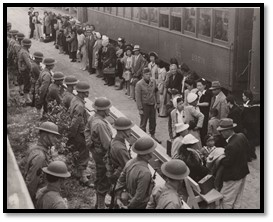University Communications and Marketing
"Memories of Heart Mountain" and "Colors of Confinement"
October 9, 2015
Contacts:
Brent Roberts, MSUB Library, 657-1655
Joy Barber, City College, 247-3075
University Relations, 657-2266 – Story by Blair Koch
MSU BILLINGS NEWS SERVICES — Just south of Billings, in a secluded area of northern Wyoming, once stood the
Heart Mountain Internment Camp. It was one of 10 prison camps erected throughout the
American west during World War II. The barracks-filled and razor-wire enclosures were
meant to separate Japanese American citizens from the rest of the population during
the war, lest they be enemy combatants.
From the age of 9 to 12, Sam Mihara was detained at Heart Mountain. He will share
his experience in a lecture entitled, "Memories of Heart Mountain," at 6:30 p.m.,
in Library Room 148 on October 14. The event is sponsored by the MSUB Library.
"Very few people have heard about these camps," Mihara said, noting that this didn't
happen in a dictatorship country far away. "It didn't happen in a lot of places around
the world. It happened right here in America and people don't know about it."
Compared to the temperate San Francisco, California of his childhood, Mihara would
learn why living in the stark Wyoming climate would be considered a violation of the
Geneva Convention of Human Rights.
"It was extreme conditions at the camp," Mihara recalled. "To go from California
to Northern Wyoming, it's actually against the rules. It was a human rights violation."
Mihara was not grappling with the challenge alone. He and his family were among 120,000
West Coast residents of Japanese  ancestry (though most were U.S.-born and American citizens) forced to move.
ancestry (though most were U.S.-born and American citizens) forced to move.
This was spurred by an atmosphere of WWII hysteria and authorized by an Executive
Order signed by President Franklin D. Roosevelt on February 19, 1942.
Once Mihara's family got to Heart Mountain in Wyoming the community attempted to
recreate a new-normal and make the best of the situation by building grammar schools
for the young children. However, the local residents seethed at the idea and pressured
the government to stop any progress made inside the camp.
"There was a lot of hysteria and the media, it was alarming, they drove the people
nuts," Mihara said. "The architecture of the buildings changed. The local people wanted
it to look like a prison and so the government made it look like a prison."
Conditions at Heart Mountain were frequently inadequate. Sam's large and extended
family lived in a single room, measuring 20 feet by 20 feet, for their entire imprisonment.
Medical care was scarce and food rations often ran low.
Mihara left the prison a relatively healthy, although forever scarred, pre-teen and
returned to San Francisco. Eventually, he studied and became a rocket scientist with
The Boeing Company. Others, of course, didn't fare as well. Some of his family died
and his father went blind while imprisoned.
Mihara developed his presentation in hopes of educating people across the country
to ensure the egregious civil rights violations he suffered at the hands of his government
aren't dealt to citizens again.
"It could happen again. Most definitely, it could happen again," said Mihara, who
now lives in Huntington Beach, California.
City College Writing Professor Joy Barber was instrumental in helping bring Mihara's
presentation to the school.
With Heart Mountain about 90 miles from Billings, Mihara's presentation will hopefully
elevate the locality and relevance of his message, as well as open the doors to the
historic and civic education around the issues of race, diversity and civil rights,
Barber said.
"Bringing Sam Mihara to MSUB provides a unique opportunity to contribute to these
discussions and infuse the Billings community with personal, first-hand testimony
about WWII internment," Barber said. "Despite many people's deep interest in WWII,
the internment of Japanese residents in the U.S. during the war is often overlooked.
And yet, the questions about national security, racial profiling and community "tolerance"
internment raises remain relevant today. The story of internment becomes a critical
moment which can teach us about the important civil rights lessons of our region's
and nation's past."
Accompanying the lecture on the university campus is a unique exhibit on the City College campus titled “Colors of Confinement” The exhibit is sponsored by a Humanities Montana grant in conjunction with the MSUB Library. “Colors of Confinement” showcases 18 rare Kodachrome photographs taken by internee Bill Manbo. The photos documents life at Heart Mountain during internment. The exhibit was compiled from the archives at Heart Mountain by Dr. Eric Muller of the University of North Carolina.
Both the event and exhibit are free and open the public. “Colors of Confinement” will run through November.
